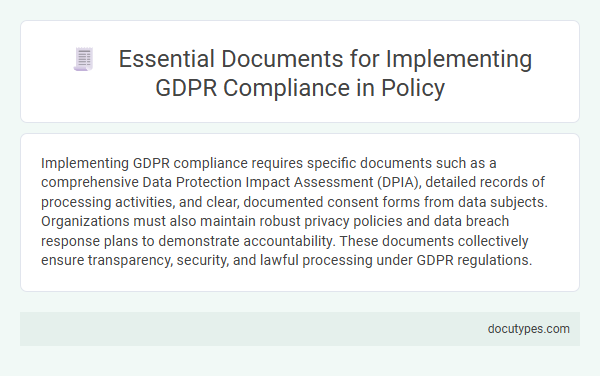Implementing GDPR compliance requires specific documents such as a comprehensive Data Protection Impact Assessment (DPIA), detailed records of processing activities, and clear, documented consent forms from data subjects. Organizations must also maintain robust privacy policies and data breach response plans to demonstrate accountability. These documents collectively ensure transparency, security, and lawful processing under GDPR regulations.
Introduction to GDPR Compliance Policies
Implementing GDPR compliance requires a clear understanding of essential documentation to ensure lawful data processing. Your organization must prepare specific policies and records to meet regulatory standards effectively.
- Data Protection Policy - Outlines the organization's approach to safeguarding personal data in compliance with GDPR principles.
- Records of Processing Activities (ROPA) - Details all personal data processing activities undertaken by the organization.
- Data Breach Response Plan - Defines procedures for identifying, reporting, and managing data breaches promptly under GDPR rules.
Importance of Documentation in GDPR Implementation
Documentation is a critical element in GDPR compliance, serving as evidence of adherence to data protection principles. Key documents include Data Protection Impact Assessments (DPIAs), Records of Processing Activities (ROPA), and Data Processing Agreements (DPAs) with third parties. Proper documentation ensures transparency, accountability, and facilitates regulatory audits, making it indispensable for GDPR implementation.
Data Processing Records and Registers
To implement GDPR compliance, maintaining accurate Data Processing Records is essential. These records must detail the categories of personal data processed, processing purposes, data recipients, and retention periods. Your Data Processing Registers serve as crucial evidence of accountability and transparency under the regulation.
Privacy Policy and Notice Templates
Implementing GDPR compliance requires specific documents, primarily a comprehensive Privacy Policy and clear Notice Templates. These documents inform users about data collection, processing practices, and their rights under GDPR.
The Privacy Policy must detail data controller information, purpose of processing, legal basis, data retention periods, and user rights. Notice Templates, such as cookie notices and consent forms, ensure transparent communication and lawful data collection consent.
Data Subject Consent Forms
| Document Type | Description | Key Components | Purpose |
|---|---|---|---|
| Data Subject Consent Forms | Legal documents used to obtain explicit permission from individuals before processing their personal data under GDPR. |
|
Ensures lawful basis for data processing by establishing informed, freely given, and unambiguous consent from data subjects. |
Data Protection Impact Assessment (DPIA) Documentation
Implementing GDPR compliance requires a comprehensive set of documents, with Data Protection Impact Assessment (DPIA) documentation playing a critical role. DPIA documents identify and minimize data protection risks associated with processing activities.
DPIA documentation must include a detailed description of the data processing operations, an assessment of the necessity and proportionality of processing, and an evaluation of potential risks to data subjects. It should also outline measures to mitigate identified risks and demonstrate compliance with GDPR principles. Maintaining up-to-date DPIA records is essential for regulatory audits and ensuring ongoing data protection accountability.
Data Breach Notification and Incident Response Plans
What specific documents are required for implementing GDPR compliance regarding data breach notification and incident response plans?
Organizations must maintain a Data Breach Notification Policy outlining procedures for timely reporting of breaches within 72 hours to supervisory authorities. A detailed Incident Response Plan is essential to manage, investigate, and mitigate data breaches effectively, ensuring compliance with GDPR mandates.
Data Subject Rights Request Procedures
Implementing GDPR compliance requires specific documentation to manage Data Subject Rights Request Procedures effectively. These documents help organizations respond promptly and lawfully to individuals' data access or modification requests.
- Data Subject Access Request (DSAR) Form - A standardized form used to capture requests from individuals exercising their GDPR rights.
- Request Handling Policy - A detailed policy outlining the process to verify, respond, and document data subject requests within GDPR timelines.
- Audit Trail Records - Logs and documentation that track the receipt, processing, and resolution of data subject requests for compliance verification.
Third-Party Processor Agreements
Implementing GDPR compliance necessitates thorough documentation, particularly concerning third-party processors handling personal data. Third-party processor agreements are vital to ensure data protection responsibilities are clearly defined and adhered to.
- Data Processing Agreement (DPA) - A legally binding contract outlining the roles and responsibilities of data controllers and processors under GDPR.
- Security Measures Documentation - Evidence of technical and organizational safeguards the processor implements to protect personal data.
- Audit and Compliance Clauses - Provisions that grant the data controller the right to audit the processor's GDPR compliance regularly.
Clear and precise third-party processor agreements are essential for maintaining GDPR compliance and mitigating risk in data handling processes.
What Specific Documents Are Required for Implementing GDPR Compliance? Infographic

